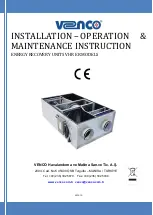
20
•
Remove the sealing caps from the air connectors.
•
Using ventilation tube materials with the lowest possible air resistance, connect the ventilation technology
components to one another so that they are air-tight.
•
The unit connectors are made from EPP and have a sleeve size of DN 125.
•
The outdoor air and exhaust air tubes must be insulated in such a way that they are sealed against vapour
diffusion. This prevents condensate from forming on the outside of the ventilation tubes.
•
If – when installing the exhaust air tube – it is not possible to avoid a low point between the exhaust air
connector on the unit and the exhaust air outlet, a connection to the condensate drain must be provided at this
point. This is because the exhaust air is saturated with steam at cold outdoor temperatures and droplets may
be deposited on the inner wall of the tube.
•
The exhaust air pipework that runs from the unit connector to the roof terminal must not be straight.
Otherwise, any ice that forms could drop onto the blades of the exhaust air fan when it thaws, causing
damage to the blades.
Fig. 20: Drainage arrangement for outdoor and exhaust air tubes
•
If an attenuator is fitted at the exhaust air connector, it must be routed upwards with a bend to prevent it being
drenched by condensate running back from the exhaust air tube.
•
If the exhaust air is routed above the roof, a double-walled or insulated roof passage must be installed. This
prevents condensate from forming between the roof boards.
•
For the supply and extract air ducts, we recommend using thermal and vapour-tight insulation to prevent
unnecessary temperature losses in both the summer and winter.
Connecting the condensate drain hose
In the heat exchanger, the warm extract air is cooled by the outdoor air. This causes the moisture in the room air to
condense inside the heat exchanger. The condensate that forms in the heat exchanger is routed to the sink valve.
The sink valve screw connection
A
has a 1¼" male thread for the siphon. This is located on the bottom of the FOCUS
unit, with the exact position varying according to the unit version and design.
Fig. 19: Arrangement of the air connections Unit version LEFT and unit version RIGHT
Outdoor air
Exhaust air
Exhaust air
Outdoor air
Содержание FOCUS 200 Base
Страница 1: ...Translation of the original instruction manual Heat Recovery Unit FOCUS 200 Base...
Страница 30: ...30 Dimensions Fig 33 Dimensional drawing...
Страница 31: ...31 FOCUS 200 Base terminal scheme Fig 34 Terminal assignment terminal plan...
Страница 36: ...36 PDE Manual_Focus 200 Base_V1 1 V1122 DE Subject to change...
















































